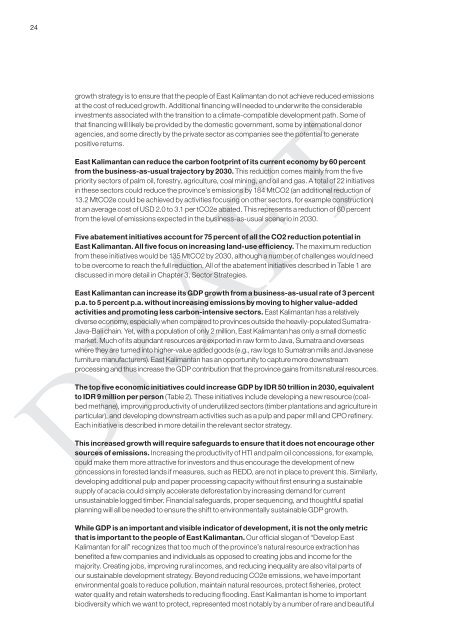East Kalimantan Environmentally Sustainable Development Strategy
East Kalimantan Environmentally Sustainable Development Strategy
East Kalimantan Environmentally Sustainable Development Strategy
You also want an ePaper? Increase the reach of your titles
YUMPU automatically turns print PDFs into web optimized ePapers that Google loves.
24<br />
growth strategy is to ensure that the people of <strong>East</strong> <strong>Kalimantan</strong> do not achieve reduced emissions<br />
at the cost of reduced growth. Additional financing will needed to underwrite the considerable<br />
investments associated with the transition to a climate-compatible development path. Some of<br />
that financing will likely be provided by the domestic government, some by international donor<br />
agencies, and some directly by the private sector as companies see the potential to generate<br />
positive returns.<br />
<strong>East</strong> <strong>Kalimantan</strong> can reduce the carbon footprint of its current economy by 60 percent<br />
from the business-as-usual trajectory by 2030. This reduction comes mainly from the five<br />
priority sectors of palm oil, forestry, agriculture, coal mining, and oil and gas. A total of 22 initiatives<br />
in these sectors could reduce the province’s emissions by 184 MtCO2 (an additional reduction of<br />
13.2 MtCO2e could be achieved by activities focusing on other sectors, for example construction)<br />
at an average cost of USD 2.0 to 3.1 per tCO2e abated. This represents a reduction of 60 percent<br />
from the level of emissions expected in the business-as-usual scenario in 2030.<br />
Five abatement initiatives account for 75 percent of all the CO2 reduction potential in<br />
<strong>East</strong> <strong>Kalimantan</strong>. All five focus on increasing land-use efficiency. The maximum reduction<br />
from these initiatives would be 135 MtCO2 by 2030, although a number of challenges would need<br />
to be overcome to reach the full reduction. All of the abatement initiatives described in Table 1 are<br />
discussed in more detail in Chapter 3, Sector Strategies.<br />
<strong>East</strong> <strong>Kalimantan</strong> can increase its GDP growth from a business-as-usual rate of 3 percent<br />
p.a. to 5 percent p.a. without increasing emissions by moving to higher value-added<br />
activities and promoting less carbon-intensive sectors. <strong>East</strong> <strong>Kalimantan</strong> has a relatively<br />
diverse economy, especially when compared to provinces outside the heavily-populated Sumatra-<br />
Java-Bali chain. Yet, with a population of only 2 million, <strong>East</strong> <strong>Kalimantan</strong> has only a small domestic<br />
market. Much of its abundant resources are exported in raw form to Java, Sumatra and overseas<br />
where they are turned into higher-value added goods (e.g., raw logs to Sumatran mills and Javanese<br />
furniture manufacturers). <strong>East</strong> <strong>Kalimantan</strong> has an opportunity to capture more downstream<br />
processing and thus increase the GDP contribution that the province gains from its natural resources.<br />
The top five economic initiatives could increase GDP by IDR 50 trillion in 2030, equivalent<br />
to IDR 9 million per person (Table 2). These initiatives include developing a new resource (coalbed<br />
methane), improving productivity of underutilized sectors (timber plantations and agriculture in<br />
particular), and developing downstream activities such as a pulp and paper mill and CPO refinery.<br />
Each initiative is described in more detail in the relevant sector strategy.<br />
DRAFT<br />
This increased growth will require safeguards to ensure that it does not encourage other<br />
sources of emissions. Increasing the productivity of HTI and palm oil concessions, for example,<br />
could make them more attractive for investors and thus encourage the development of new<br />
concessions in forested lands if measures, such as REDD, are not in place to prevent this. Similarly,<br />
developing additional pulp and paper processing capacity without first ensuring a sustainable<br />
supply of acacia could simply accelerate deforestation by increasing demand for current<br />
unsustainable logged timber. Financial safeguards, proper sequencing, and thoughtful spatial<br />
planning will all be needed to ensure the shift to environmentally sustainable GDP growth.<br />
While GDP is an important and visible indicator of development, it is not the only metric<br />
that is important to the people of <strong>East</strong> <strong>Kalimantan</strong>. Our official slogan of “Develop <strong>East</strong><br />
<strong>Kalimantan</strong> for all” recognizes that too much of the province’s natural resource extraction has<br />
benefited a few companies and individuals as opposed to creating jobs and income for the<br />
majority. Creating jobs, improving rural incomes, and reducing inequality are also vital parts of<br />
our sustainable development strategy. Beyond reducing CO2e emissions, we have important<br />
environmental goals to reduce pollution, maintain natural resources, protect fisheries, protect<br />
water quality and retain watersheds to reducing flooding. <strong>East</strong> <strong>Kalimantan</strong> is home to important<br />
biodiversity which we want to protect, represented most notably by a number of rare and beautiful

















